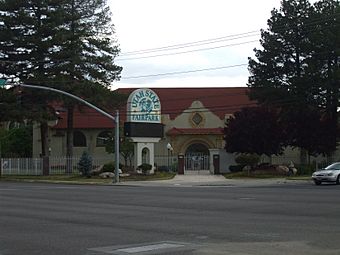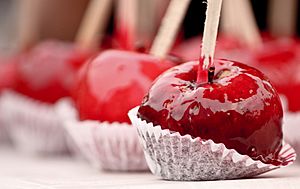Utah State Fair facts for kids
Quick facts for kids Utah State Fair |
|
|---|---|
 |
|
| Genre | State fair |
| Date(s) | 10–20 September 2020 |
| Frequency | Annually, begins the Thursday after Labor Day |
| Location(s) | 155 North 1000 West Salt Lake City, Utah United States |
| Years active | 1856–1916, 1919–1941, since 1945 |
The Utah State Fair is a super fun event held every year in Salt Lake City, Utah. It takes place at the Utah State Fairpark, which is a special place listed on the National Register of Historic Places. The fair usually starts on the first Thursday after Labor Day and lasts for 11 exciting days. It's a place where people come together to enjoy music, shows, delicious food, and see amazing exhibits!
Contents
Fair Fun: Entertainment and Shows
Every year, the Utah State Fair brings in awesome musical guests and other performers. You can see everything from big concerts to thrilling events like the demolition derby and PRCA rodeo. Many shows are free with your ticket, but some bigger concerts might cost extra.
Big Stage Shows
The main stage, called the grandstand, features top performers. Past shows have included popular bands like Plain White T's and Foreigner. You might even see famous singers like Amy Grant or Prince Royce. Most of these shows are free, but you'll need a special ticket for a seat.
Outdoor Fun and Acts
Beyond the main stage, there's lots of free entertainment happening all over the fairgrounds! You can watch exciting acts like the Paul Bunyan Lumberjack Show, where lumberjacks show off their skills. There's also The Great American Duck Race, where ducks compete. Look out for cool performers like Freddy Fusion with his science magic show!
Gazebo Performances
The gazebo on the fairgrounds is another spot for free entertainment. It hosts different performers throughout the fair. You might catch local bands, singers, or even more science magic shows! It's a great place to relax and enjoy some tunes.
Amazing Exhibits
The fair is a fantastic place to see all sorts of exhibits! You can explore different areas like:
- Living Arts: See creative projects and crafts.
- 4-H Food and Clothing: Check out what young people have made and grown.
- Agriculture: Learn about farming and crops.
- Creative Arts and Fine Arts: Admire beautiful paintings, sculptures, and other artworks.
- Floriculture: See stunning flower displays.
- Home Arts: Discover homemade items and skills.
- Cook-offs: Watch or taste delicious food from cooking competitions.
- Photography: Enjoy amazing photos.
- Livestock: Meet farm animals like beef cattle, dairy cows, goats, poultry (chickens, ducks), rabbits, sheep, and pigs. There are even special sections for younger farmers showing their animals!
Delicious Fair Food
One of the best parts of the fair is the food! You can find all kinds of yummy treats. There are classic fair foods like corn dogs and sweet funnel cakes. You might also try unique items like Navajo tacos. Don't forget to look for candy apples and other sweet snacks!
Fair Rules for a Fun Visit
To make sure everyone has a safe and happy time, the fair has a few rules:
- Only service animals are allowed, with special permission.
- You can't bring vehicles like bicycles, skateboards, or scooters inside without permission.
- You can bring your own food, but no alcohol is allowed.
- Please be respectful and use kind language.
- Don't litter or damage anything at the Fairpark.
- Always follow the official fair hours.
History of the Fair
The Utah State Fair has a long and interesting history, going all the way back to the early days of Utah.
How the Fair Started
When the first pioneers settled in Utah, they had to grow and make everything they needed because they were far from other towns. To help everyone learn new farming and manufacturing skills, a group called the Deseret Agricultural and Manufacturing (D.A.M.) Society was formed in 1856. This group, with help from the LDS Church, decided to hold an annual event called "The Deseret Fair." Its goal was to show off local products and encourage people to create things from Utah's own resources.
The Very First Fair
The first "Deseret Fair" happened from October 2-4, 1856. It was held in a building in downtown Salt Lake City. In the basement, they showed off farm products, even "large hens from Land's End England." The first floor had handmade items like saddles and buckskin suits. Upstairs, you could see fruits, vegetables, and household goods.
Winning an award back then was mostly about pride! Prizes were small, often just 50 cents to $3, or a special "diploma." Even Brigham Young, a famous leader, won $25 for the "Best Stallion" and a first prize for "Best celery." Other awards were given for things like the best cow, best-fenced farm, and even good handwriting! While there weren't rides like today, they did have a "spirited plowing match" in a field nearby.
The Early Years of the Fair
To help pay for the early fairs, people could buy "life memberships." Church leaders also helped by collecting small fees from members to support the fair. Many early fairs were held at the same time as the LDS Church's semi-annual meetings, making it a big event for everyone.
The awards given out had special symbols, like the "All-seeing Eye" and the beehive, which is Utah's state symbol. This showed the importance of hard work and community. Because Utah was so isolated, the fair was a key way for people to learn new farming and manufacturing methods. The D.A.M. Society even brought in seeds, trees, and plants from other countries like Japan to help local industries grow.
Changes Over Time
The fair didn't happen every year in the beginning, especially during tough times when there wasn't much to show. Finding a place to hold the fair was also a challenge. It moved around to different buildings in Salt Lake City for many years.
In 1896, when Utah became a state, the fair officially became the "Utah State Fair." It was now managed by the state government. The fair's purpose changed too. While it still celebrated hard work and local products, it also became a way to promote Utah to the rest of the country and encourage trade. It was seen as a way to "advance the countries welfare."
Fairpark Home
In 1902, the state bought 65 acres of land, which became the permanent home of the fair, now called the Fairpark. The first building there was the Horticulture Building, later renamed Promontory Hall. It's a beautiful building that still displays exhibits today.
Some of the Fairpark's old buildings were fixed up in the 1980s. The Manufacturing and Mining Building, which was in bad shape, was renovated and reopened as the Grand Building in 1989. It's a major landmark at the Fairpark.
Since 1995, the Utah State Fair has been run by a special board that works to make sure the fair is profitable and doesn't need taxpayer money. They do this by hosting events at the Fairpark all year long.
The Utah State Fair continues to celebrate Utah's traditions and products. You can find "Utah's Own" Food Court, featuring foods grown and prepared right here in the state. The fair tries to mix the best of Utah's past with new ideas and technology. Even during the COVID-19 pandemic in 2020, the fair still happened with some changes, showing how important it is to Utahns!
The Fairpark: More Than Just the Fair
|
Utah State Fair Grounds
|
|

Fair grounds main entrance, May 2009
|
|
| Lua error in Module:Location_map at line 420: attempt to index field 'wikibase' (a nil value). | |
| Location | 10th West and North Temple streets Salt Lake City, Utah United States |
|---|---|
| Area | 50 acres (20 ha) |
| Built | 1902 |
| Architect | Multiple |
| Architectural style | Mixed (more Than 2 Styles From Different Periods) |
| NRHP reference No. | 81000583 |
| Added to NRHP | January 27, 1981 |
The Fairpark isn't just for the Utah State Fair! It's used all year round for many other events and concerts. For example, it has hosted big music festivals like the Warped Tour. The Fairpark's main goal is "Preserving Utah's Traditions," making sure this special place continues to be a part of Utah's history and future. The fairgrounds were recognized as a historic place in 1981.
Images for kids



